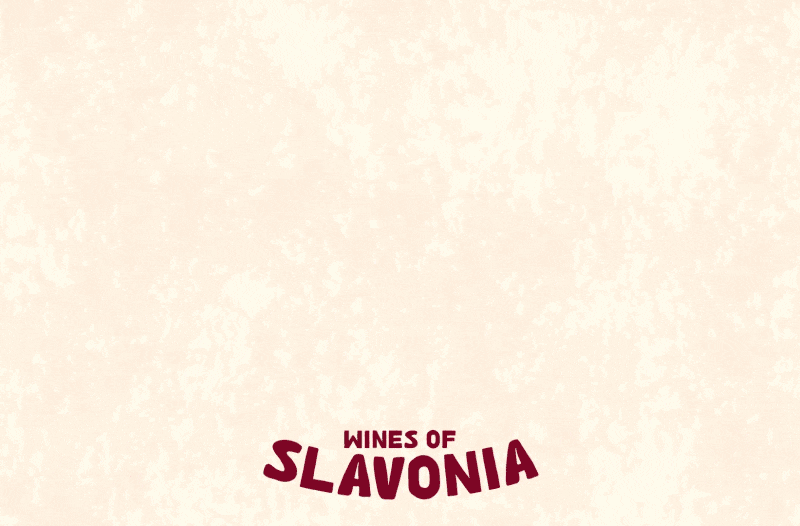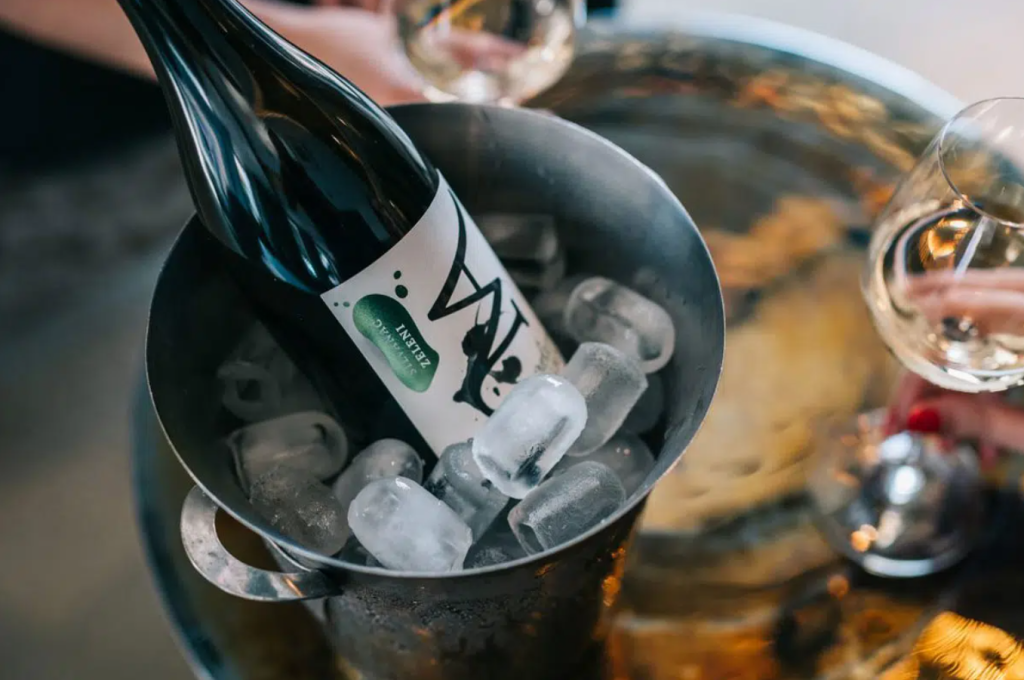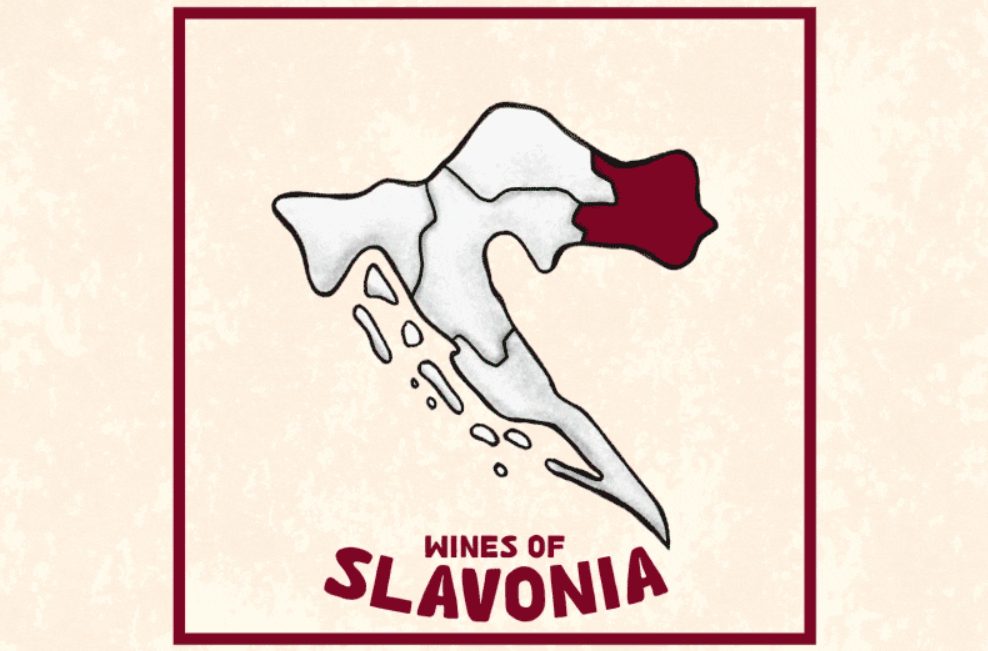January 12, 2024. – As Wine & more writes, Slavonian wines stand as a testament to the rich tapestry of Croatian viticulture, weaving together centuries-old traditions and modern winemaking innovations.
As we embark on this captivating journey through the wines of Slavonia, we peel back the layers to uncover the distinct characteristics and global recognition that make these wines truly exceptional.

Characteristics of Slavonian Wines
The essence of Slavonian wines lies in their deep ties to the land and heritage, making them an integral part of Croatian winemaking.
Often managed by family-run establishments, the knowledge of winemaking is passed down through generations, creating a continuum of expertise.
Slavonia boasts a diverse range of grape varieties, each playing a role in the region’s distinct wine profile. The interplay between indigenous and international grape varieties, the region’s terroir, and the fusion of traditional and modern winemaking techniques result in a plethora of wine types.
Terroir Influence
In Slavonia, the term “terroir” encapsulates the environmental factors influencing grape growth and, consequently, the flavors and aromas of the resulting wines. The harmonious interplay of elements contributes to the exceptional quality of wines from specific positions.
Soil Composition
Slavonia’s vineyards thrive in mineral-rich soils, a legacy of ancient geological processes. The predominantly loamy and clayey soils provide an ideal foundation for grapevines, imparting unique mineral nuances and contributing to the well-structured and elegant character of Slavonian wines.
Continental Climate
Slavonia experiences a continental climate characterized by hot summers and cold winters. Significant temperature variations foster complexity and balance in the wines.
Warm summers ensure optimal ripening, while cool nights preserve the grapes’ natural acidity, resulting in wines with both depth and freshness. The region is gradually becoming warmer due to climate change.
Topography and Microclimates
The undulating landscapes of Slavonia create microclimates within vineyards, influencing temperature variations, sun exposure, and air circulation.
Winemakers leverage these microclimates to cultivate specific grape varieties, adding layers of complexity to Slavonian wines.
Unique SLAVONIAN Grape Varieties
In the vineyards of Slavonia, a medley of indigenous and international grape varieties flourishes, giving rise to a diverse range of wines that cater to every discerning taste.
Let’s delve into some of the standout grape varieties that define the character of Slavonian wines:
Graševina: Queen of Slavonia
Graševina reigns supreme among Slavonian grape varieties, celebrated for its crisp acidity thriving in Slavonia’s continental climate.
Graševina’s roots in Slavonia run deep, thriving in the region’s continental climate and finding an ideal home in the sun-drenched vineyards. Its cultivation has become a tradition and a symbol of Slavonian winemaking.
The important magic of Graševina lies in its ability to mirror the terroir of Slavonia. The grape flourishes in the region’s unique combination of soil, climate, and topography. The loamy and clayey soils impart a distinct minerality, while the continental climate, with its warm summers and cold winters, provides the perfect conditions for Graševina to thrive.
The resulting wines are characterized by crisp acidity, refreshing citrus notes, and a remarkable versatility that captivates the palate. This, at least, is the most dominant style of Graševina. In Slavonia, Graševina can achieve almost anything.
Frankovka: The Noble Red

Frankovka, known as Blaufränkisch in the wider viticultural world, stands as a noble red grape variety that has left an indelible mark on the tapestry of Slavonian winemaking. Frankovka has found a second home in the sun-soaked vineyards of Slavonia, and one of its best representatives is Martin Albus Frankovka.
The magic of Frankovka unfolds in the embrace of Slavonia’s terroir. The grape thrives on the loamy and clayey soils, absorbing the mineral nuances that lend depth to the wines. The continental climate, marked by warm summers and cold winters, imparts a dynamic character to Frankovka, resulting in wines with a deep ruby hue, complex flavor profile, and velvety tannins.
The magic of Frankovka unfolds in the embrace of Slavonia’s terroir. The grape thrives on the loamy and clayey soils, absorbing the mineral nuances that lend depth to the wines.
The continental climate, marked by warm summers and cold winters, imparts a dynamic character to Frankovka, resulting in wines with a deep ruby hue, complex flavor profile, and velvety tannins.
In the culinary realm, Frankovka shines as a versatile companion. Its ability to balance fruitiness and structure makes it an ideal match for various cuisines.
Slavonian winemakers skillfully craft it into single-varietal wines and impressive blends, showcasing its adaptability and ability to express the nuances of the region.
Traminer: Aromatic Excellence
Also known as Gewürztraminer, Traminer adds an aromatic flair to Slavonian vineyards. Producing wines with intense floral aromas, lychee undertones, and a hint of spice, Traminer reflects the unique character of Slavonia’s terroir, creating a sensory experience for wine enthusiasts seeking a fragrant and expressive white wine.
Silvaner: A Hidden Gem

Silvaner, a venerable grape variety, finds its home in the Orahovica subregion of Slavonia. This ancient variety, known for its sensitivity to terroir, has discovered an ideal habitat in Orahovica. Orahovica, with its untouched nature and stunning landscapes, sets the stage for Silvaner to express its full potential.
The palate is treated to a symphony of flavors, with floral notes, hints of citrus, and a subtle minerality dancing in harmony.
The special feature of the Silvaner from the vineyards of Orahovica lies in the very geographical location and the climate, which are responsible for the perfect fruity aroma of this extremely drinkable wine.
The Martin Albus Silvaner, basking in the sun-kissed southeast-facing slopes’ warmth, benefits from constant air movement and a deliberately controlled yield. These elements converge to create a wine of impeccable harmony, where fruity aromas of green apples, vineyard peach, and citrus intertwine seamlessly with a complex flavor profile that lingers on the palate for an extended finish.
This Silvaner is a testament to the exquisite alignment between the grape variety and the Orahovica wine region, offering yet another compelling proof of their perfect synergy.
The Slavonia and the Danube WINE REGION
Did you know that Slavonia and Danube cover over 30% of vineyards in Croatia? Slavonia and Podunavlje, the ruling realms of white wine varieties with Graševina at the helm, paint a landscape adorned with vast vineyards and an ever-increasing array of top-notch wines.
Popular Slavonian Wine Subregions
The Danube River weaves a narrative of three extraordinary vineyards: Srijem, Erdut, and Baranja. Nestled in the embrace of the central Slavonian highlands, these subregion vineyards contribute to the diverse winemaking heritage of Slavonia.
This enchanting landscape encompasses Kutjevo, Požega – Pleternica, Orahovica – Slatina, Feričanci, Pakrac, Daruvar, Nova Gradiška, Slavonski Brod, Đakovo, and Virovitica.
Positioned at altitudes ranging from 150 to 450 meters, these vineyards are home to numerous winemakers crafting some of the finest wines from continental wine-growing climates worldwide.
Kutjevo WINE SUBREGION
The Kutjevo wine subregion stands as a beacon of excellence within the Croatian winemaking landscape, where wines command recognition on the global stage. Spanning approximately 55 km, this viticultural haven encompasses around 800 hectares of meticulously tended vines, predominantly on the southern slopes of Papuk and Krndija. The historical roots of viticulture in Kutjevo run deep, evident in numerous documents highlighting the enduring significance of grape cultivation since ancient times.
The climate in Kutjevo’s vineyards is ideal, shielded from chilly northern winds and basking in abundant heat, humidity, and sunlight. The soil, a crucial component of terroir, contributes to the unique character of Kutjevo wines. Comprising brown leached to bronze pseudo gleys, the soil composition varies at higher elevations, featuring richer stone debris and pockets of diverse elements.
Orahovica WINE SUBREGION
In the pristine landscapes of Slavonia, the Orahovica wine subregion unfolds amidst breathtaking beauty, harmonizing with the UNESCO Geopark Papuk’s edges. Situated at elevations ranging from 160 to 250 meters above sea level, the vineyards, with a southern exposure, create an environment conducive to nurturing grapes of the highest quality.
The heart of Orahovica’s viticultural pride is Silvanac zeleni (Silvaner), one of the world’s oldest grape varieties. Within the embrace of Orahovica’s terroir, Silvaner discovers its perfect habitat, giving rise to top-tier wines acknowledged by oenologists across the globe.
Ilok WINE SUBREGION
For millennia, the elixir of wine has woven itself into the very fabric of Ilok, the most eastern wine subregion in Croatia. Vineyards adorn the surrounding hills, each mild slope telling a unique story in the region’s vinous legacy. The crowning jewel of Ilok’s vineyards is the celebrated Traminer, often crafted into dry or semi-dry wines. Beyond Traminer, the vineyards proudly cultivate a symphony of varietals, including Graševina, Pinot Grigio, Riesling, Chardonnay, Sauvignon, and distinguished red grapes like Frankovka, Merlot, and Cabernet Sauvignon.
Ilok bears the influence of the Danube, with expectations of alluvial effects on soil composition. However, the viticultural positions vary significantly across individual localities, shaping the nuanced flavors of the wines.
Baranja Wine Subregion
In the translation from Hungarian, “Baranja” gracefully unfolds as “wine mother,” encapsulating the essence of this northeastern Croatian region. The Hungarian influence paints a natural tapestry across Baranja, where the Drava River serves as an administrative boundary but fails to demarcate the historical kinship in traditions.
Baranja boasts some of Croatia’s most fertile soils, a testament to its exceptionally flat terrain. Overlooking the region from the north stands the imposing hill, “Banska kosa” (241 m), adding a touch of elevation to the landscape. A distinctive feature of the vineyards here is the presence of “gators” (wine cellars) nestled in “surduk”, the steep, cut roads that gracefully wind through the hills, adding a unique charm to the viticultural panorama.
Erdut Wine Subregion
The Erdut wine subregion unfurls its splendor along the right bank of the Danube, tracing a picturesque path from Aljmaš through Erdut to Dalj. Nestled on the eastern slopes of the Dalj mountain, adjacent to the Danube River, the Erdut vineyards create a harmonious blend of terroir and tradition.
Stretching across fertile loess alluvium in an east-west direction on the slopes, the vineyards ascend to their highest points at 130 to 190 meters before gently descending southward. In terms of variety, white grapes take center stage, constituting a dominant share in overall production. Among the prominent white grape varieties are Graševina, Chardonnay, Riesling, Traminac, Pinot Grigio, while Zweigelt, Cabernet Sauvignon, Pinot Noir, Merlot, and Frankovka elegantly represent the red spectrum.
Notable Slavonian Wine Varietals
Graševina, Frankovka, and Traminac are considered crown jewels of Slavonian viticulture, offering a sensory adventure with their nuanced flavors and aromas. However, Slavonia holds a repertoire of notable wine varietals that define the legion’s vinous identity.
Slavonian Wine and Food pairings
- Graševina with Freshwater Fish
Fresh style Graševina, with its crisp acidity and citrus notes, complements the delicate flavours of freshwater fish. Try it with grilled trout or carp for a refreshing and harmonious pairing.
- Frankovka with Hearty Stews
The robust character of Frankovka pairs wonderfully with hearty stews, such as goulash or “čobanac”. The dark fruit flavours and velvety tannins enhance the richness of the dish.
- Traminac with Spicy Dishes
The aromatic profile of dry or semi-dry Traminac complements spicy dishes exceptionally well. Try it with Slavonian specialities like fish paprikaš for a tantalizing experience.
- Frankovka Rosé with Charcuterie

The versatility of Frankovka Rosé makes it a perfect match for a charcuterie board. Enjoy it with local cured meats, cheeses, and pickled vegetables for a delightful array of flavours.
- Silvaner with Grilled Chicken
Silvaner’s subtle minerality and citrus notes pair beautifully with grilled chicken. Whether marinated or seasoned with local herbs, the combination will surely please the palate.
- Graševina Ice Wine with Desserts
Indulge in the sweetness of Graševina Ice Wine paired with decadent desserts like walnut cake or honey pastries. The luscious sweetness of the wine enhances the dessert experience.
- Late Harvest Silvaner with Foie Gras
Late-harvested ripe Silvaner aromatic intensity pairs exceptionally well with the decadence of foie gras. Savour the luxurious combination for a sophisticated dining experience.
CONCLUSION
Slavonia offers a must-explore experience for wine enthusiasts seeking authenticity, history, and a taste of Croatia’s vinous soul.
Beyond the wine, the region is steeped in history, with centuries-old wine cellars and vineyards waiting to be explored by curious visitors.
In Slavonia, you can witness firsthand the passion and dedication of the winemakers who have been perfecting their craft for generations.
NOTE: The article was originally written by wineandmore.com












